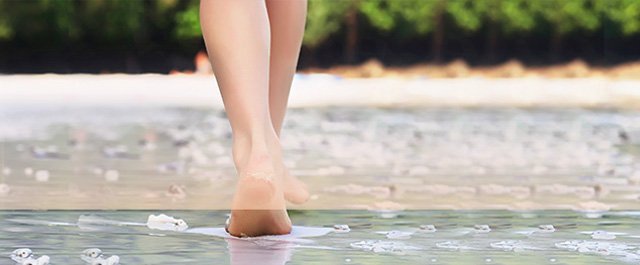Flat Foot
Paediatric Flat foot
Paediatric Flat foot, also known as “fallen arches” or the medical term Pes planus, is a deformity of the feet in which the arch, which runs lengthwise along the sole of the feet, has collapsed to the ground or has not formed at all. In this condition, the foot remains flat rather than arched as in normal feet. Infants’ feet may appear flat because the arch has yet to form. This is normal and the arch of the foot usually develops around the age of 3-5 years. Flat foot may affect children as well as adults and can occur in one foot or both feet.
Paediatric Flat foot can cause problems if the condition persists into adulthood and does not resolve itself. The condition can cause joint pain in the leg when walking or an aching pain in the feet.
In order to learn more about Paediatric Flat Foot, it is important to understand normal foot anatomy.
Normal Foot Anatomy
The foot can be divided into three anatomical sections called the hindfoot, midfoot, and forefoot.
Hindfoot
The hindfoot consists of the Talus bone or ankle bone and the calcaneous bone or heel bone. The calcaneous bone is the largest bone in your foot while the talus bone is the highest bone in your foot. The calcaneous joins the talus bone at the subtalar joint enabling the foot to rotate at the ankle. The hindfoot connects the midfoot to the ankle at the transverse tarsal joint.
Midfoot
The midfoot contains five tarsal bones: the navicular bone, the cuboid bone, and 3 cuneiform bones. It connects the forefoot to the hindfoot with muscles and ligaments. The main ligament is the plantar fascia ligament. The midfoot is responsible for forming the arches of your feet and acts as a shock absorber when walking or running. The midfoot connects to the forefoot at the five tarsometatarsal joints.
Forefoot
The forefoot consists of your toe bones, called phalanges, and metatarsal bones, the long bones in your feet. Phalanges connect to metatarsals at the ball of the foot by joints called phalange metatarsal joints. Each toe has 3 phalange bones and 2 joints, while the big toe contains two phalange bones, two joints, and two tiny, round sesamoid bones that enable the toe to move up and down. Sesamoid bones are bones that develop inside of a tendon over a bony prominence. The first metatarsal bone connected to the big toe is the shortest and thickest of the metatarsals and is the location for the attachment of several tendons. This bone is important for its role in propulsion and weight bearing.
Soft Tissue Anatomy
Our feet and ankle bones are held in place and supported by various soft tissues.
Cartilage Shiny and smooth, cartilage allows smooth movement where two bones come in contact with each other.
Tendons Tendons are soft tissue that connects muscles to bones to provide support. The Achilles tendon, also called the heel cord, is the largest and strongest tendon in the body. Located on the back of the lower leg it wraps around the calcaneous, or heel bone.
Ligaments Ligaments are strong rope like tissue that connects bones to other bones and help hold tendons in place providing stability to the joints. The plantar fascia is the longest ligament in the foot, originating at the calcaneous, heel bone, and continuing along the bottom surface of the foot to the forefoot. It is responsible for the arches of the foot and provides shock absorption.
Muscles Muscles are fibrous tissue capable of contracting to cause body movement. There are 20 muscles in the foot and these are classified as intrinsic or extrinsic. The intrinsic muscles are those located in the foot and are responsible for toe movement. The extrinsic muscles are located outside the foot in the lower leg. The gastrocnemius or calf muscle is the largest of these and assists with movement of the foot.
Bursae Bursae are small fluid filled sacs that decrease friction between tendons and bone or skin. Bursae contain special cells called synovial cells that secrete a lubricating fluid.
The pediatric foot is largely made of cartilage, with less bone than the adult foot. Because cartilage is softer than bone and more malleable, flatfoot deformity can lead to permanent structural changes in the bones and joints into adulthood.
Causes and Risk Factors
Paediatric flat foot is a common condition that can run in families. Often it is caused by loose connections between joints and excess baby fat deposits between foot bones which make the entire foot touch the floor when the child stands up. A rare condition called Tarsal Coalition can also cause flatfoot. In this condition, two or more bones of the foot join together abnormally causing stiff and painful flat feet.
Signs and Symptoms
Children with flatfoot deformity may have one or more of the following signs and symptoms:
- Inside arch of the foot is flattened
- Heel bone may be turned outward
- Inner aspect of the foot may appear bowed out
- Pain in the foot, leg, knee, hip, or lower back
- Pain in the heels causing difficultly with walking/running
- Discomfort with wearing shoes
- Inability to bear weight on affected foot
- Tired, achy feet with prolonged standing or walking
Diagnosis
Your doctor will perform a careful physical examination of your child’s foot and observe the child in standing and sitting positions. If an arch forms when the child stands on his toes, then flat foot seems to be flexible and no further tests are necessary. If pain is associated with the condition, or if the arch does not form on standing on toes, then X-rays are ordered to assess the severity of the deformity. A computed tomography (CT) scan is done if tarsal coalition is suspected and if tendon injury is presumed a magnetic resonance imaging (MRI) is recommended.
Treatment
Treatment is usually not required if your child does not exhibit any symptoms. Your doctor may want to monitor your child’s condition periodically to assess for changes. If, however, your child is experiencing symptoms, treatment options are available.
Conservative Treatment
When symptoms are present or develop, your doctor may suggest one or more of the following non-surgical treatment options:
- Activity modification: Avoid having your child participate in activities that cause pain such as walking or standing for long periods of time.
- Orthotic devices: Your surgeon may advise on the use of custom made orthotic devices that are worn inside the shoes to support the arch of the foot.
- Physical therapy: Stretching exercises of the heel can provide pain relief.
- Medications: Pain relieving medications such as ibuprofen are prescribed to reduce pain and inflammation.
- Shoe modification: Using a well-fitting, supportive shoe can help relieve aching pain caused by flatfoot.
Surgical Treatment
Surgery is rarely needed to treat most cases of paediatric flat foot, however, if conservative treatment options fail to relieve your child’s symptoms then surgery may be necessary to resolve the problem. The goal of surgery is to eliminate pain, improve mobility, and halt progression of the condition.
Flat foot surgery is performed in a hospital operating room with the patient under general anaesthesia.
Your surgeon will make an incision over the foot
Depending on your child’s condition, various procedures may be performed and can include tendon transfers, tendon lengthening, joint fusion, or implant insertion.
Tendon Transfer: In conditions where the tendon is ruptured and no fixed deformity present, a FDL tendon transfer to the navicular is performed.
Your surgeon will make a 10cm long incision starting from the medial malleolus continuing up to about 1cm behind the medial (towards the midline) border of the tibia.
The tibialis posterior (TP) tendon is exposed and the tendon sheath is opened entirely. TP tendon is then resected leaving behind a 3-cm stump of the tendon attached to the navicular.
FDL tendon harvest: The Flexor Digitorum Longus (FDL) tendon sheath which is found just below the PT tendon sheath is opened and cut as distally as possible. The FDL Tendon is brought into the PT sheath through the drill hole made across the navicular tuberosity. It is then anchored on to the stump of the TP tendon with help of sutures.
Tendon lengthening (Z-plasty lengthening): Your surgeon will make a 2-inch lengthwise incision behind the ankle, just above the heel. After the Achilles tendon is exposed, a Z-cut is made halfway across the tendon. Then the tendon is split up to the middle. A final cut is made at the opposite side of the tendon. The tendon is stretched to make it longer by moving the two halves of the tendon apart. The overlapping sections are then sutured back.
Immediately after the procedure, the leg is immobilized by providing a below-the-knee cast. The cast is removed after 3-4 weeks.
Joint Fusion (Talonavicular Fusion): Talonavicular fusion is a procedure in which the talus and navicular bones are fused. It is performed under general anaesthesia. A 4-5 cm long cut is made on the inner aspect of the foot. The joint is exposed and the joint surfaces are reshaped to correct the deformity. The joint is then fused together with screws, pins or staples. A bone graft taken from the tibia may be used with the screws.
Implant insertion: Implant insertion is a surgical procedure performed under general anaesthesia. The patient lies on his back with the foot turned inwards. Your surgeon will make a 1 cm long cut on the outer aspect of the foot just in front of the lateral malleolus. The implant is placed into the sinus tarsi, a space surrounded by the talus and calcaneous bone. After the procedure, a dressing is placed followed by which a plaster cast is given.
In children, the implant should be removed at a later stage to allow further growth.
Once your surgeon has performed the procedure specific to your child’s condition, the incision is closed and covered with a sterile bandage.
Post-Operative Guidelines
Common Post-operative guidelines include:
You will have a dressing over the surgery site that your surgeon will remove after about a week.
It is important to keep the dressing clean and dry. No showering or bathing until your surgeon allows.
Sutures are usually removed at 10-14 days unless dissolvable sutures were used in the surgery.
Elevating the foot above heart level when sitting and applying ice packs will help to reduce swelling
Medications for pain will be prescribed to keep your child comfortable
Feeding your child, a healthy diet will promote healing
Risks and Complications
As with any major surgery there are potential risks involved. The decision to proceed with the surgery is made because the advantages of surgery outweigh the potential disadvantages.
It is important that you are informed of these risks before the surgery takes place.
Complications can be medical (general) or specific to foot surgery.
Medical complications include those of the anaesthetic and your general well-being. Almost any medical condition can occur so this list is not complete. Complications include:
- Activity modification: Avoid having your child participate in activities that cause pain such as walking or standing for long periods of time.
- Orthotic devices: Your surgeon may advise on the use of custom made orthotic devices that are worn inside the shoes to support the arch of the foot.
- Physical therapy: Stretching exercises of the heel can provide pain relief.
- Medications: Pain relieving medications such as ibuprofen are prescribed to reduce pain and inflammation.
- Shoe modification: Using a well-fitting, supportive shoe can help relieve aching pain caused by flatfoot.
The majority of patients suffer no complications following surgical correction of flat foot, however, complications can occur following foot surgery and include:
- Infection
- Nerve damage causing numbness to the skin over the toe area.
- Inadequate correction of the deformity requiring further surgical intervention

 Menu
Menu



